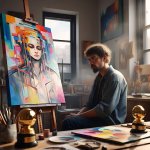In 2022, an AI-generated artwork won a prestigious art competition in Colorado. The backlash was swift—and fierce. Human artists, critics, and audiences were left asking a fundamental question:
Should AI-generated art be eligible for awards originally meant for human creativity?
This debate isn’t just about art—it’s about the very nature of creativity, and whether machines should be allowed to compete in spaces built by and for people.
The Case For AI in Art Competitions
Advocates for AI-generated art argue that the medium is simply evolving.
Just as photography once challenged painting, and digital art challenged traditional techniques, AI is just the next evolution in creative tools. If the final product evokes emotion, tells a story, or demonstrates mastery—why should the method matter?
AI-generated pieces:
Are often directed and curated by humans
Require prompt engineering, editing, and aesthetic judgment
Push boundaries of style and imagination
Represent a collaboration between human intent and machine output
Proponents ask: if the judging criteria are visual impact, composition, or originality—shouldn’t the result be judged, not the tool?
 The Case Against Awarding AI-Generated Art
The Case Against Awarding AI-Generated Art
On the other hand, critics argue that AI art should not compete with human-made art—especially in traditional award categories.
Here’s why:
AI doesn’t “feel” anything—it imitates
It scrapes billions of existing artworks without consent (raising ethical concerns)
It can generate hundreds of variations in seconds, creating an unfair advantage
It blurs originality, ownership, and authorship
To many, giving awards to AI-generated pieces undermines the years of training, discipline, and emotional vulnerability that human artists invest in their work. It's not just a technological leap—it's an existential threat.
And let’s be honest: if an AI wins again—how long before human artists stop submitting altogether?
 A Middle Ground? Create New Categories
A Middle Ground? Create New Categories
Rather than ban or fully accept AI into existing competitions, some suggest creating separate award categories—like “Best AI-Assisted Art” or “Most Innovative Use of Generative Tools.”
This approach:
Preserves the integrity of traditional contests
Encourages exploration of new media
Acknowledges the artist's role in guiding AI
Creates transparency in judging and classification
It mirrors how digital animation, CGI, and VFX earned their own awards over time.
 Final Brushstrokes: Tool or Artist?
Final Brushstrokes: Tool or Artist?
AI can create art. But can it be an artist? That’s the real question.
Do we judge the soul behind the canvas—or just what’s on the canvas?
As AI continues to enter galleries, contests, and markets, society will need to redefine creativity, authorship, and fairness in a world where the line between man and machine grows thinner every day.
 What do you think?
What do you think?
Should AI art ever beat human-made work in creative competitions? Or is it a slippery slope that devalues true artistry?
Should AI-generated art be eligible for awards originally meant for human creativity?
This debate isn’t just about art—it’s about the very nature of creativity, and whether machines should be allowed to compete in spaces built by and for people.
The Case For AI in Art Competitions
Advocates for AI-generated art argue that the medium is simply evolving.
Just as photography once challenged painting, and digital art challenged traditional techniques, AI is just the next evolution in creative tools. If the final product evokes emotion, tells a story, or demonstrates mastery—why should the method matter?
AI-generated pieces:
Are often directed and curated by humans
Require prompt engineering, editing, and aesthetic judgment
Push boundaries of style and imagination
Represent a collaboration between human intent and machine output
Proponents ask: if the judging criteria are visual impact, composition, or originality—shouldn’t the result be judged, not the tool?
On the other hand, critics argue that AI art should not compete with human-made art—especially in traditional award categories.
Here’s why:
AI doesn’t “feel” anything—it imitates
It scrapes billions of existing artworks without consent (raising ethical concerns)
It can generate hundreds of variations in seconds, creating an unfair advantage
It blurs originality, ownership, and authorship
To many, giving awards to AI-generated pieces undermines the years of training, discipline, and emotional vulnerability that human artists invest in their work. It's not just a technological leap—it's an existential threat.
And let’s be honest: if an AI wins again—how long before human artists stop submitting altogether?
Rather than ban or fully accept AI into existing competitions, some suggest creating separate award categories—like “Best AI-Assisted Art” or “Most Innovative Use of Generative Tools.”
This approach:
Preserves the integrity of traditional contests
Encourages exploration of new media
Acknowledges the artist's role in guiding AI
Creates transparency in judging and classification
It mirrors how digital animation, CGI, and VFX earned their own awards over time.
AI can create art. But can it be an artist? That’s the real question.
Do we judge the soul behind the canvas—or just what’s on the canvas?
As AI continues to enter galleries, contests, and markets, society will need to redefine creativity, authorship, and fairness in a world where the line between man and machine grows thinner every day.
Should AI art ever beat human-made work in creative competitions? Or is it a slippery slope that devalues true artistry?

